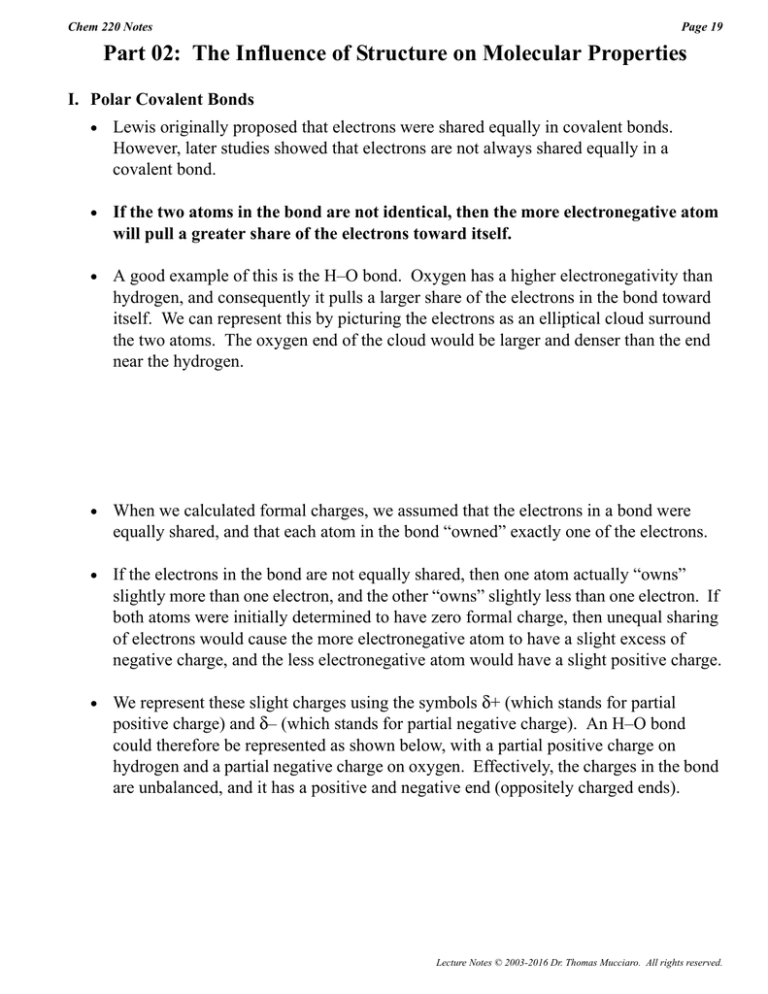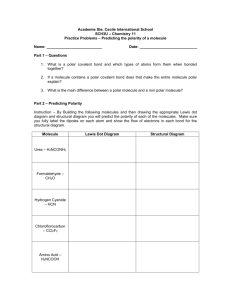
Chem 220 Notes
Page 19
Part 02: The Influence of Structure on Molecular Properties
I. Polar Covalent Bonds
•
Lewis originally proposed that electrons were shared equally in covalent bonds.
However, later studies showed that electrons are not always shared equally in a
covalent bond.
•
If the two atoms in the bond are not identical, then the more electronegative atom
will pull a greater share of the electrons toward itself.
•
A good example of this is the H–O bond. Oxygen has a higher electronegativity than
hydrogen, and consequently it pulls a larger share of the electrons in the bond toward
itself. We can represent this by picturing the electrons as an elliptical cloud surround
the two atoms. The oxygen end of the cloud would be larger and denser than the end
near the hydrogen.
•
When we calculated formal charges, we assumed that the electrons in a bond were
equally shared, and that each atom in the bond “owned” exactly one of the electrons.
•
If the electrons in the bond are not equally shared, then one atom actually “owns”
slightly more than one electron, and the other “owns” slightly less than one electron. If
both atoms were initially determined to have zero formal charge, then unequal sharing
of electrons would cause the more electronegative atom to have a slight excess of
negative charge, and the less electronegative atom would have a slight positive charge.
•
We represent these slight charges using the symbols δ+ (which stands for partial
positive charge) and δ– (which stands for partial negative charge). An H–O bond
could therefore be represented as shown below, with a partial positive charge on
hydrogen and a partial negative charge on oxygen. Effectively, the charges in the bond
are unbalanced, and it has a positive and negative end (oppositely charged ends).
Lecture Notes © 2003-2016 Dr. Thomas Mucciaro. All rights reserved.
Chem 220 Notes
Part 02: The Influence of Structure on Molecular Properties
Page 20
•
Covalent bonds with oppositely charged ends are called polar covalent bonds (or polar
bonds).
•
Polarity is the general property of have oppositely charged ends.
•
To represent the polarity of a bond, we use an arrow that points to the negative end of
the bond and has a cross on the positive end of the bond.
•
The size of the polarity in a bond is called the dipole moment, and it depends on both
the difference in electronegativity and the length of the bond. The bond polarity arrow
is considered a symbol for the dipole moment of a bond.
II. Polar Molecules (Dipoles)
•
When a molecule has oppositely charged ends, it is called a polar molecule or a dipole.
•
Molecule polarity is more complex than bond polarity, because it involves both
the polarity of bonds and the three-dimensional shape of the molecule.
•
To determine if a molecule is polar, we first need to know the shape of the molecule.
We then must add all the bond dipoles using vector addition.
•
To vectors are arrows that indicate the size and direction of a number. Bond dipole
moment arrows are vectors because the indicate the size and direction of the dipole
moment.
•
To add vectors, we line them up with the arrow of one vector pointing to the tail of the
next vector. When all the vectors are lined up this way, the sum is an arrow from the
start of the first vector to the arrowhead of the last vector. For example, look at the
vector sum of the bond dipoles for water (H2O):
The vector sum of the bond dipoles is another vector, with a length greater than zero.
We say that water has a net dipole moment. The dipole moment points from the
positive end of the molecule to the negative end.
Lecture Notes © 2003-2016 Dr. Thomas Mucciaro. All rights reserved.
Chem 220 Notes
Part 02: The Influence of Structure on Molecular Properties
Page 21
•
A molecule can have polar bond and not be a polar molecule. This occurs when the
bond dipoles balance each other out in three-dimensional space.
•
A molecule will not be polar when the vector sum of its bond dipoles is zero (the last
vector ends up at the starting point of the first vector. In this case we say the molecule
has no net dipole moment and is non-polar.
•
One example of a non-polar molecule is carbon dioxide, CO2. Although the two C=O
bonds are polar bonds, the point in exactly opposite directions. Therefore, the bond
dipoles balance each other out in space.
•
Carbon dioxide is a non-polar molecule. If we put the δ+ and δ– charges on the
molecule, we can see that it doesn’t have oppositely charged ends. Instead, the ends of
the molecule are both negatively charged (and the middle is positive). This is another
way of visualizing the polarity of a molecule.
Lecture Notes © 2003-2016 Dr. Thomas Mucciaro. All rights reserved.
Relative Strength
Interaction
Picture
Description
Attraction between two oppositely
charged ions.
Chem 220 Notes
III.Intermolecular Forces
Ion-Ion
Strongest
Example: ionic salts,
such as NaCl
Example: NaCl dissolving in water
Hydrogen Bonding
Attraction between two dipoles
(polar molecules).
Dipole-Dipole
Example: polar liquids, such as
water
Weakest
London Dispersion Forces
Attraction between temporary
induced charges in non-polar
molecules
Page 22
Lecture Notes © 2003-2016 Dr. Thomas Mucciaro. All rights reserved.
Charge attraction between a
hydrogen bonded to a strongly
electronegative atom (N, O, or F),
and an atom with a lone pair
Part 02: The Influence of Structure on Molecular Properties
Ion-Dipole
Attraction between ion and
oppositely charged end of a dipole
(polar molecule).



